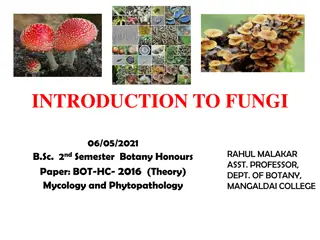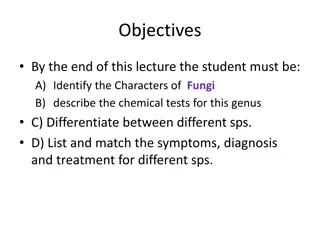
Exploring the Classification of Fungi in Kingdom Fungi
Discover the diverse world of fungi through this seminar presentation, covering the introduction to fungi, their classification into major divisions like Zygomycota, Ascomycota, Basidiomycota, Chytridiomycota, and Glomeromycota, as well as their economic importance. Learn about the unique characteristics and roles of these eukaryotic organisms in ecosystems.
Uploaded on | 0 Views
Download Presentation

Please find below an Image/Link to download the presentation.
The content on the website is provided AS IS for your information and personal use only. It may not be sold, licensed, or shared on other websites without obtaining consent from the author. If you encounter any issues during the download, it is possible that the publisher has removed the file from their server.
You are allowed to download the files provided on this website for personal or commercial use, subject to the condition that they are used lawfully. All files are the property of their respective owners.
The content on the website is provided AS IS for your information and personal use only. It may not be sold, licensed, or shared on other websites without obtaining consent from the author.
E N D
Presentation Transcript
SeminarPpt.com Seminar On Classification of Fungi Submitted to: Seminarppt.com Submitted By Seminarppt.com
Table of Contents 1. Introduction to Fungi 2. Classification of Fungi Kingdom Fungi Division Zygomycota Division Ascomycota Division Basidiomycota Division Chytridiomycota Division Glomeromycota 3. Economic Importance of Fungi 4. Conclusion
Introduction Fungi are eukaryotic organisms that include microorganisms such as yeasts, molds, and mushrooms. They are distinct from plants, animals, and bacteria, with their unique kingdom, Fungi. Fungi play essential roles in nutrient cycling in ecosystems.
Classification Fungi are classified based on their reproductive structures and molecular data. Major divisions include Kingdom Fungi Division Zygomycota Division Ascomycota Division Basidiomycota Division Chytridiomycota Division Glomeromycota
Kingdom Fungi All fungi belong to the Kingdom of Fungi. are further classified into various divisions based on their specific characteristics and reproductive methods.
Division Zygomycota Commonly known as conjugation fungi. Produce zygospores during sexual reproduction. Examples: Rhizopus (bread mold), Mucor.
Division Ascomycota Known as sac fungi due to the formation of asci (sac-like structures) containing spores. Largest division with about 75% of all fungi. Examples: Yeast (Saccharomyces), Penicillium, Aspergillus.
Division Basidiomycota Known as club fungi, characterized by basidia (club-shaped structures) where spores form. Examples: Agaricus (common mushroom), Amanita, Boletus.
Division Chytridiomycota Known as chytrids, the simplest and most primitive fungi. Produce zoospores with flagella for movement. Examples: Batrachochytrium (causes amphibian chytridiomycosis).
Division Glomeromycota Form arbuscular mycorrhizae with plant roots. Play a crucial role in plant nutrition and soil health. Lack of sexual reproduction structures. Examples: Glomus species.
Economic Importance Antibiotics: Penicillin from Penicillium notatum. Fermentation: Yeasts in baking, brewing, and winemaking. Biotechnology: Enzyme production, bioremediation. Agriculture: Biological control agents against pests and diseases.
Conclusion Fungi are a diverse and vital group of organisms with significant ecological, medical, and economic roles. Understanding their classification helps in appreciating their functions and applications.
References References Wikipedia.org Google.com Seminarppt.com Studymafia.org






















